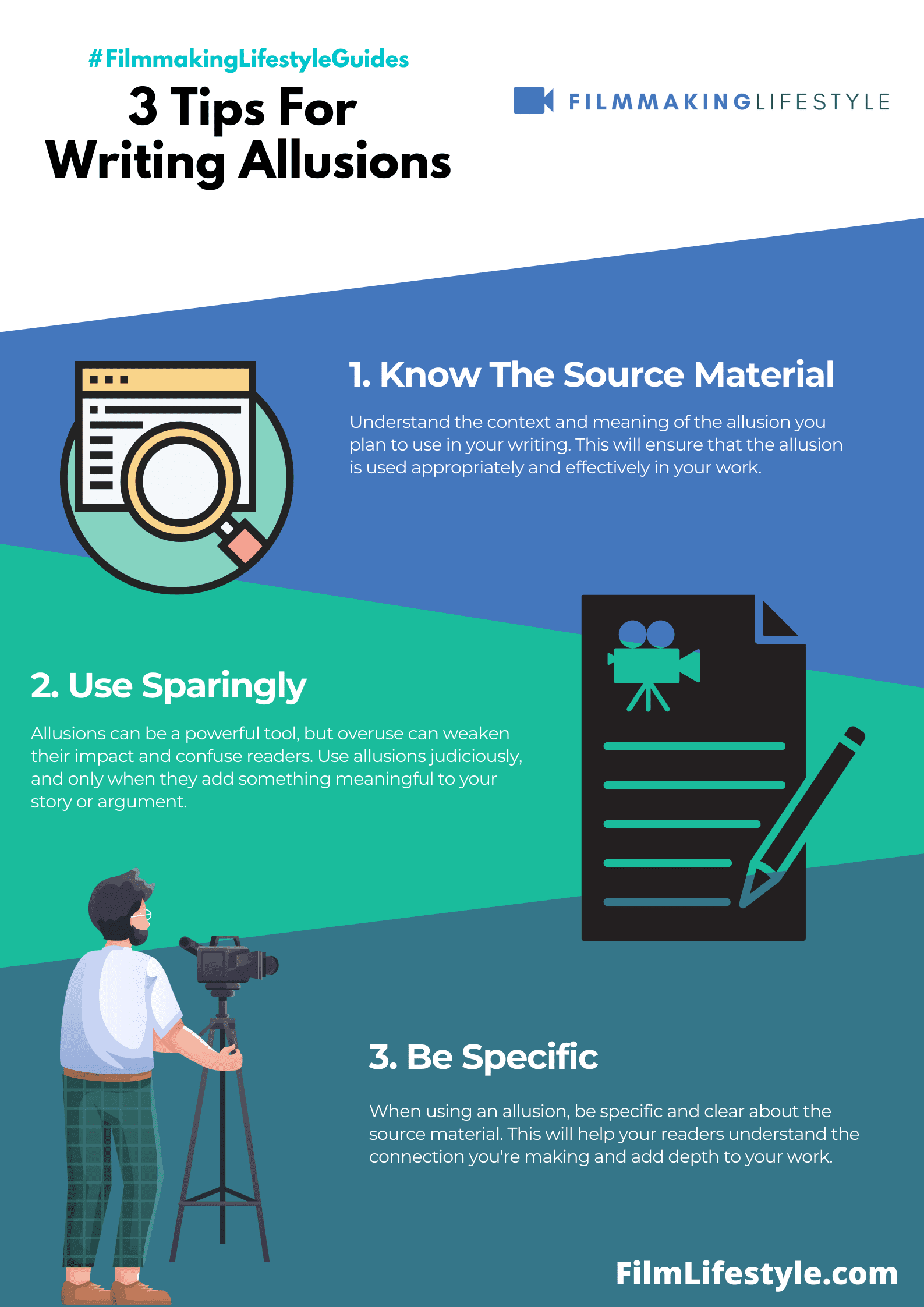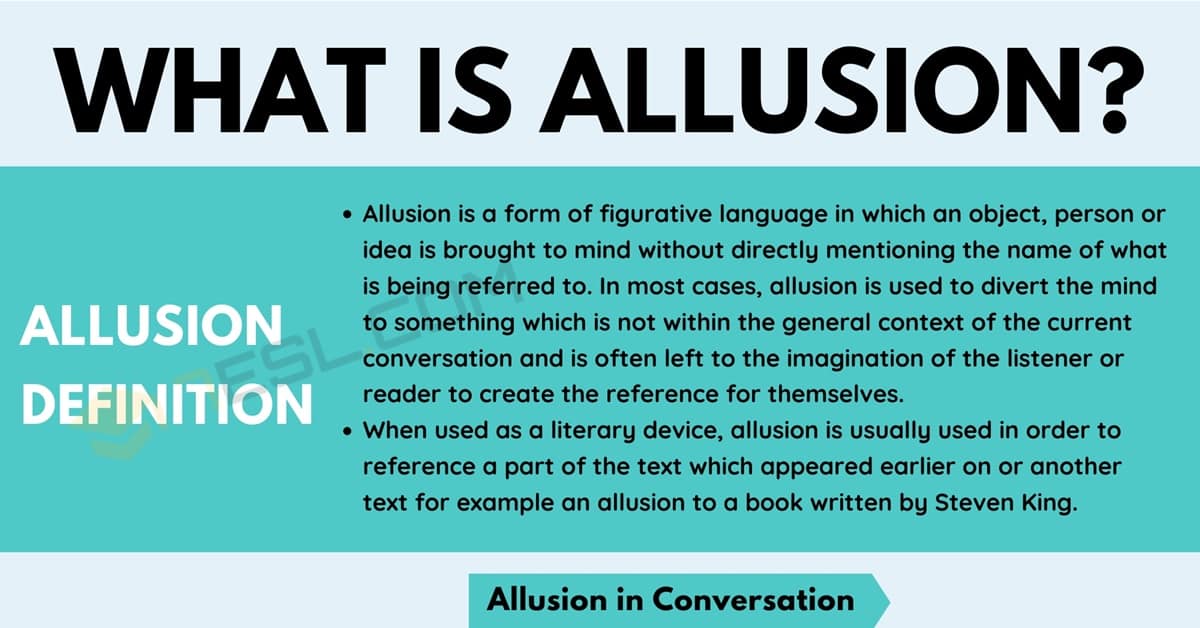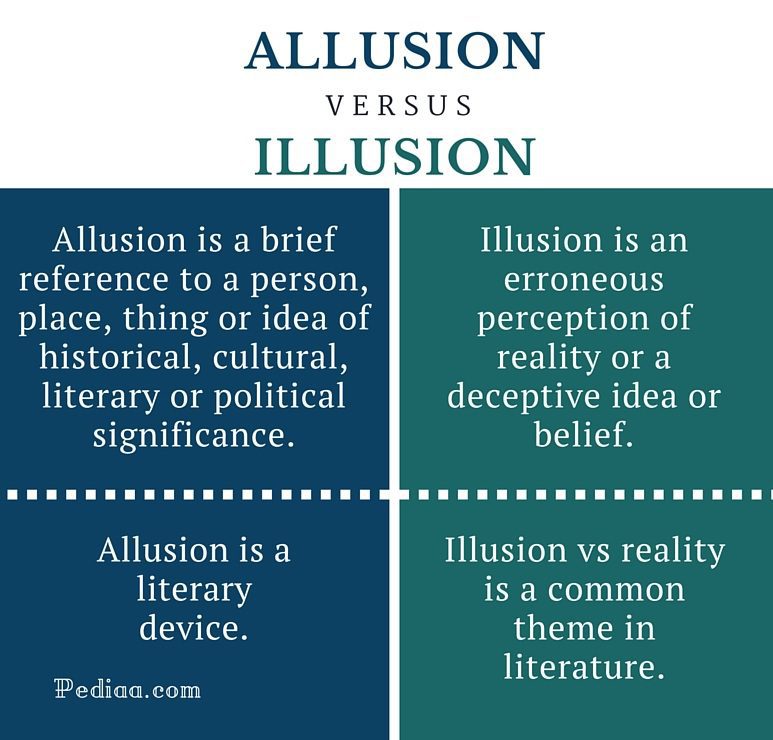The allusion is a figure of speech in which an author refers to something or someone by indirect means.
Allusions are most often found in literature, where they usually serve as a device for character development and theme exploration.
Allusions are a type of literary device that makes references to people, places, or events. It is often used in poems and novels.
An allusion is a reference to something that you are not explicitly talking about. This can be in the form of an image, word, or phrase.
The most common type of allusions is literary references such as naming characters after other famous people from different literature.
WHAT IS AN ALLUSION
What Is An Allusion?
An allusion is a reference to something in literature, history, politics, or popular culture.
Allusions are often used as literary devices and can be found in many different types of writing.
Ever stumbled upon a sentence that whisked you away to a different time or place, without leaving the page?
That’s the power of an allusion, a writer’s secret weapon for adding depth and context.
In our dive into literary devices, we’ll uncover how allusions work their magic, subtly linking the reader to a larger conversation.
We’ll explore the types of allusions that authors love to weave into their work, from historical to literary, and how they can transform a simple narrative into a rich tapestry of meaning.
Get ready to enhance your reading experience as we reveal the art of the allusion.
What Is An Allusion?
In the realm of narrative, an allusion is a powerful literary device that we find invaluable.
It’s the subtle reference to a person, place, thing, or idea of historical, cultural, literary, or political significance.
Not overt or explicit, these references lead the audience towards a deeper understanding of the creator’s message.
When we encounter an allusion in a film or book, it acts as a kind of shorthand.
Take, for instance, a character described as a “regular Einstein,” instantly we’re in the know that they possess incredible intellect, perhaps even genius.
Or imagine a dystopian film where the protagonist’s home is named East Egg — fans of The Great Gatsby will recognize the implication of wealth and social relevance.
To weave an allusion into a narrative effectively requires a deft touch.
We must ensure that our allusion enhances the story rather than distracting viewers with a need for extensive background knowledge.
It’s about striking balance, creating layers of meaning that are appreciated by those who recognize them without alienating those who do not.
The Power Of Allusion In Writing
Allusions serve as a powerful tool to enrich narratives, allowing us to employ layers of meanings beyond the straightforward text.
They provide a shorthand way of evoking broader themes or emotions without expounding on them explicitly.
Writers in diverse fields, from literature to film making, utilize this technique to connect with their audience on a more profound level.
Incorporating allusions in our stories deepens our content, acting as a bridge between our work and the wealth of collective human experience and knowledge.
When we reference classics like The Great Gatsby or historical events such as the moon landing, we’re not just mentioning them; we’re inviting our audience into a richer world.
These nods create points of resonance between our creations and the wider cultural context, adding subtlety and texture to our narrative tapestry.
Effectively utilizing allusions, we can tap into our audience’s shared knowledge and cultural understanding.
For instance, likening a character’s downfall to Icarus’ flight too close to the sun instantly conjures up themes of hubris and fallibility.
In the filmmaking realm, such as in The Godfather, the use of allusive dialogue or imagery layers additional meaning onto scenes, giving them a timeless quality that resonates with audiences across generations.
When crafting our work, it’s key to weave these references seamlessly into the narrative so they enrich the story without becoming obstacles.
We aim to strike that balance where our use of allusion feels natural, informed, and keeps our audience engaged even if they don’t catch every reference.
Through this approach, we build a shared language, enhancing our storytelling with each allusion that lands effectively within our audience’s frame of reference.
Types Of Allusions
In our exploration of what an allusion is, it’s vital to recognize the various types.
Literary allusions reference other written works, such as novels, poems, or plays.
Directors might infuse their narratives with nods to The Great Gatsby or Hamlet, trusting that these literary echoes will resonate with their audience.
Mythological allusions draw from ancient myths and legends.
We see this when a film embodies the Herculean journey, implicitly comparing a character’s trials to those of Hercules, or when a screenwriter sprinkles in references to Achilles’ heel, suggesting vulnerability.
Historical allusions are another key type we often employ.
These references can be exceptionally potent, as they draw upon real-world events.
An example might be likening a film’s political drama to the intrigue of the Watergate scandal, giving viewers an immediate understanding of the gravity and complexity at play.
Cultural allusions hinge on shared societal knowledge, from current pop culture to traditional beliefs.
Our projects may allude to hit songs, iconic TV shows like Stranger Things, or universal experiences such as the American Dream, capturing and conveying the zeitgeist of an era.
Biblical allusions turn to religious texts for inspiration.
By alluding to stories like David and Goliath or the Garden of Eden, we tap into deep-seated narratives that carry significant weight and symbolism within the cultural psyche.
In filmmaking and storytelling at large, these types of allusions are not just flourishes of creativity but strategic instruments to deepen context and emotional impact.
They serve to bridge gaps between the story we’re spinning and the mountain of collective experiences and stories that our audience brings to the table.
Historical Allusions
When we incorporate historical allusions into our work, we’re not just referencing a period; we’re invoking the echoes of yesteryear’s events, figures, and eras that have shaped the world.
Titanic didn’t merely allude to the ill-fated ship; it brought to life the Edwardian epoch and its societal norms, coloring the story with authenticity and gravitas.
Historical allusions serve as a conduit connecting the audience to a shared past, allowing us to anchor our narrative in a particular time period without the need for extensive exposition.
Films like Gladiator and Schindler’s List leverage these allusions to create a narrative tapestry rich with the weight of human history.
By referencing the fall of the Roman Empire or the horrors of the Holocaust, we’re able to provide significant depth to our storytelling.
These allusions have the power to act as shorthand for complex backstories or overarching themes, resonating deeply with viewers who bring their understanding of history to our films.
Employing historical allusions can also break the boundaries of mere reference; they can imply a comparison or contrast between different times and cultures.
In The Godfather, the allusion to Machiavelli’s The Prince is not just a nod to a seminal work of strategic thought; it’s a comment on the nature of power and morality within the context of the American mafia.
By crafting such layers, we enrich our stories with the textures of real-world history, making them all the more compelling and relatable.
Literary Allusions
Literary allusions are whispers from one author to another, blending the threads of past narratives into new tapestries.
We use them to evoke the essence of a landmark work within our own stories without elaborate explanations.
The mere mention of a title like To Kill a Mockingbird or a character such as Jay Gatsby is enough to summon a complex tapestry of associations and emotions in our audience.
They allow us to build upon a shared literary consciousness, creating an immediate bond between viewer and film.
When a character in our screenplay alludes to The Odyssey, the audience calls upon their knowledge of Odysseus’ journey to enrich their understanding of the character’s own trials and tribulations.
In making such references, we add layers to our storytelling, compelling the audience to excavate beneath the surface.
References to Fahrenheit 451 or 1984 can instantly project the shadow of dystopia upon our narrative, offering a stark lens through which to view our own creation.
Tapping into the collective memory bank of our viewers, these allusions serve as a palette from which we extract not just color, but texture and resonance.
They remind us that our work does not exist in a vacuum but is part of an intricate and ongoing dialogue with the literature that has moved us, challenged us, and shaped how we perceive the world around us.
How Allusions Transform Narrative
When we weave allusions into our narratives, we’re not just referencing a piece of literature or a historical moment; we’re embedding a resonant fragment of a larger story into our own.
Like a hidden portal, these allusions open pathways for our audience to journey through layers of meaning, enriching the storytelling experience.
Film narratives, in particular, gain immense depth when allusions are skillfully used.
Take Blade Runner, for instance: it’s steeped in biblical and mythological allusions that shape our understanding of the characters and their world.
By drawing on these well-known stories, the film cultivates a rich soil of significance, urging viewers to look beyond the surface.
But it’s not just about depth— allusions can act as a shorthand for complex ideas.
When skillfully incorporated, they evoke a myriad of associations in a matter of seconds.
This could mean harnessing the rebellious spirit of a figure like Robin Hood, or conveying the tragedy of a Shakespearean hero, without the need for extensive backstory.
Moreover, allusions serve to connect films with timeless, human themes.
They ground the new and the innovative in the familiar, bridging a gap between the contemporary and the classical.
This not only provides viewers with a sense of continuity but also situates new works within a grander narrative tapestry.
By integrating allusions, we don’t just tell a story—we invite our audience to unearth the interconnected web of stories that make up our cultural DNA.
It’s a dialogue that extends beyond the screen, linking the personal to the archetypal, the singular to the universal.
Such is the transformative power of allusion in narrative filmmaking.
Enhancing Your Reading Experience With Allusions
When we dive into a great book, we’re not just flipping through pages; we’re embarking on a journey.
Allusions are like secret passageways in this journey, offering us shortcuts to a richer experience.
They open doors to hidden layers, letting us peek into the inexhaustible cross-references and connections that ripple through literature.
Grasping an allusion can be akin to sharing an inside joke with the author.
It creates a bond between us and the narrative, allowing for a more personalized engagement.
When we spot them, we’re rewarded with a sense of accomplishment and a deeper comprehension of the text.
Allusions also serve as a litmus test for our own knowledge and cultural literacy.
As we encounter references to works like The Great Gatsby or The Odyssey, we’re called to draw on our own literary and historical understanding.
These moments enhance our appreciation of the new work while echoing the resonance of the past.
Through allusions, authors invite us to play an active role in the creation of meaning.
They don’t just tell us a story; they encourage us to bring our experiences and imaginings to the table.
A novel isn’t just a product to consume but a dialogue in which we’re participating, threading our own narratives with those on the page.
The power of allusions lies in their ability to layer meaning and texture into a narrative.
Like a skilled chef using a pinch of an unexpected spice, a writer employs allusions to add complexity and flavor to their story, enriching our reading experience without overpowering the main dish.
These secret threads that weave through the tapestry of literature make the act of reading a dynamic and interactive adventure.
They challenge us to become detectives, piecing together the clues sprinkled throughout the narrative, and in the process, expand our understanding beyond the borders of the book in our hands.
What Is An Allusion – Wrap Up
We’ve explored the intricate role allusions play in literature, revealing their capacity to deepen the narrative and engage readers on a more profound level.
They’re not just stylistic flourishes but essential tools that writers use to weave complex tapestries of meaning.
Our journey through the world of allusion shows us that these references are key to unlocking a fuller, more rewarding reading experience.
As we close the book on this topic, remember that allusions are the threads that connect us to a larger literary and cultural conversation, making every read not just a story, but a discovery.
Frequently Asked Questions
What Is An Allusion In Writing?
An allusion in writing is a brief and indirect reference to a person, place, thing, or idea of historical, cultural, literary, or political significance.
It does not describe in detail the person or thing to which it refers.
How Do Allusions Enhance The Reading Experience?
Allusions enhance the reading experience by creating a richer narrative layer, encouraging intertextual connections, and prompting readers to engage more deeply by recognizing and interpreting these references.
Can Allusions Be Considered Secret Passageways In Literature?
Yes, allusions can be viewed as secret passageways because they offer hidden connections and shortcuts to deeper meanings that can make the reading experience more substantial and satisfying.
Why Are Allusions Like A Litmus Test For Cultural Literacy?
Allusions act as a litmus test for cultural literacy because they assume the reader has certain knowledge or familiarity with the referenced subject, thereby gauging their understanding of broader cultural context.
Do Allusions Overpower The Main Story In A Narrative?
No, allusions are designed to enrich a narrative by adding depth and texture, without overpowering the main story.
They work subtly to contribute to the broader context of the text.
How Do Allusions Make Reading An Interactive Adventure?
Allusions make reading interactive by inviting readers to become detectives of the text, challenging them to uncover the references and draw connections, thus actively engaging with the story beyond the pages.
What Role Do Readers Play When Encountering Allusions In A Book?

Readers play an important role in interpreting allusions; their knowledge and experiences contribute to how they perceive the depth and relevance of the references, making each reading experience unique.




